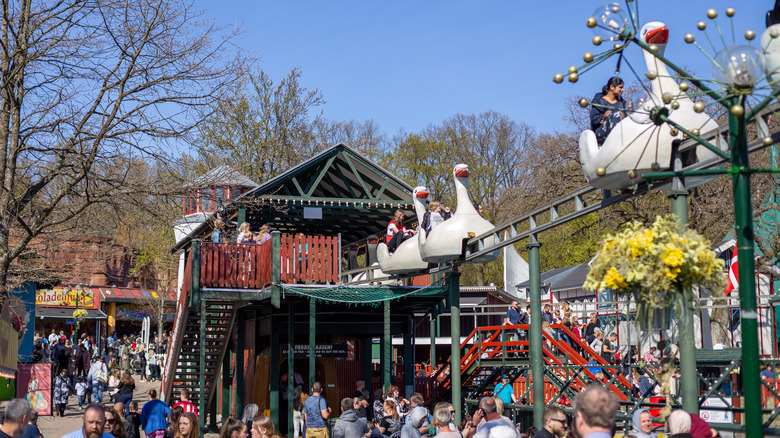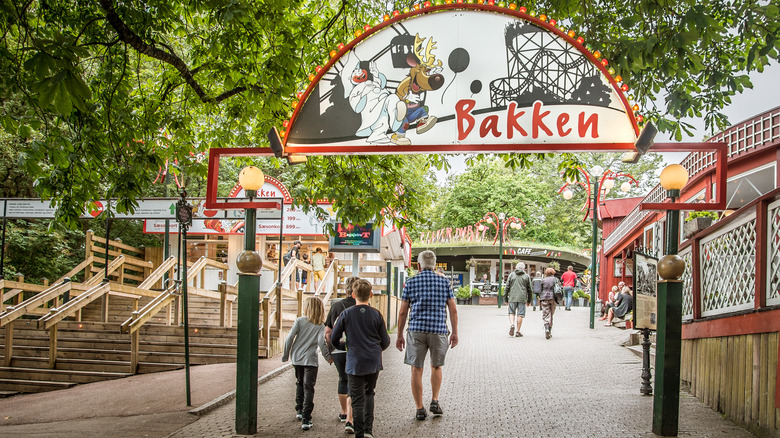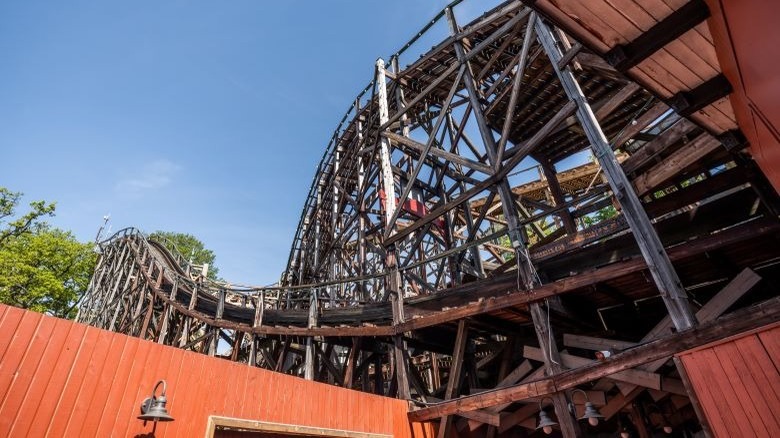The World's Oldest Amusement Park Is Older Than The United States
When it comes to amusement parks, bigger definitely seems to be better. Roller coasters, in particular, are always designed to be bigger, taller, faster, more thrilling, and more bananas. In your travels, you can visit roller coasters so thrilling that they're designed to almost kill you, or you can check out some of the oldest roller coasters in the world. But the internet is also replete with "top" coaster lists: tallest, fastest, longest, etc. And if it's not thrill rides, well, an amusement park better have all the trimmings as well: sports-type games, shooting games, carousels, funhouses, loads of food and drink options, flashing lights, loud music, you name it.
So, what are we to make of a simple, pared-down, quaint, and even sedate amusement park that you can just take a stroll through with the family while not needing paramedics on standby? Such is the case with Bakken in Denmark, or by its full name: Dyrehavsbakken (pronounced "deer-havs-bok-en"). As that pronunciation implies, there are indeed deer involved. The amusement park is in the middle of Jægersborg Dyrehaven (Jægersborg Deer Park), a stretch of "primeval Danish countryside" largely untouched for 350 years, as the Ministry of Environment of Denmark says. Bakken itself is old — really old. It used to be a pilgrimage site for people visiting nearby springs all the way back to 1583, per World Heritage Journeys. That's about 200 years before the U.S. declared independence from England, to put things in perspective. Since then, the park has grown to what it is today.
A historic site within a protected park
As World Heritage Journeys says, wanderers through Bakken will immediately notice a distinct lack of certain accoutrements found at typical, modern, steel-and-neon amusement parks. Bakken's scope is small, there's a lot of wood everywhere, there are no gigantic neon signs, no product placement and merchandizing, and so forth. That's because those things are all banned to preserve Bakken as a historical site. And historical it is, thanks in part to the selfishness of the German emperor King Frederick III. Frederick wanted the whole area, its woods, grasslands, springs, wildlife, and natural beauty all to himself, as Atlas Obscura explains. The public started heading there in 1583, Frederick locked it down in 1669, and then King Frederick V reopened it to the public in 1756.
World Heritage Journey says that Bakken became an amusement park naturally over time. Visitors went to visit the area's natural springs, and other visitors decided to open up stalls to sell things or put up tents for performances — that's it. Bit by bit Bakken became what it is today. As the official Bakken site shows, there are a bunch of independent shops, bars, restaurants, food stalls, games, bumper cars, entertainment options like circuses and clowns, and rides especially suitable for kids or the elderly. And of course, there's the standout attraction, Bakken's 91-year-old still-in-operation wooden roller coaster. This, plus the splendor of heading into the middle of protected nature within the Danish countryside, makes Bakken special indeed.
A fun, peaceful, family afternoon
Visit Copenhagen says that Jægersborg Dyrehaven — the park that houses Bakken — became a UNESCO World Heritage Site in 2015. The entire park bears the marks of its former royal ownership, such as the impressive Hermitage Hunting Lodge. The lodge is open to the public only from June through August, because it's a fragile structure, per Visit Copenhagen, and is otherwise largely surrounded only by deer. So yes, King Frederick III and other royalty didn't want Dyrehaven all to themselves just to admire nature, but to hunt it. In fact, as the Ministry of Environment of Denmark says, Dyrehaven currently houses about 2,000 deer. The park is allowed to grow and decay naturally — with trees falling as they will, so visitors should beware.
For those looking to visit Bakken, the park lies at the southern edge of Dyrehaven, easily accessible via various different train options from Copenhagen. While plane tickets to Denmark aren't free, entry to the park is, as the official Bakken site says. Summer seems the best time to stroll around and visit vendors, but October has special autumn-themed attractions, a "horror maze," and more. Atlas Obscura recommends visiting in late autumn, or even after, when there are no vendors left whatsoever. The park gates stay open year-round, even when the park is officially closed, so visitors can wander through at leisure, take in the sights, and then head on a trek through the woods.


